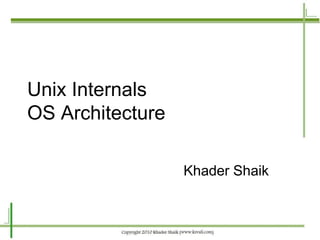
Unix Internals OS Architecture
- 1. Unix Internals OS Architecture Khader Shaik
- 2. Unix OS - Agenda • Boot Process • Shutdown Process • Process Management • Memory Management • File System • Networking 2
- 3. PROM – Programmable ROM • Small non-volatile memory loaded with vendor specific software • Performs some basic checks (POST) and finds the boot device; runs the boot program – Power-on Self Test (POST) • Usually Boot program is stored on Block 0 (boot sector) of a Boot disk • Boot program reads and loads the kernel program • System can be booted from any other devices as well if you have access to ROM > boot cdrom (on Sun) • More details are Vendor specific 3
- 4. Boot Process - Steps • Kernel checks the Memory Availability – For eg: on Solaris kernel program is located under - /kernel/unix • Probes & Configures hardware devices • Updates the entries in /dev directory – /dev directory holds the information on all hardware devices installed • Sets up all RAM tables to hold the processes information, memory allocation and open files etc • At the of the booting KERNEL creates the init process 4
- 5. Dummy Processes • Process that cannot be killed is known as DUMMY process • Used for crucial system functions • Created by Kernel during booting process – Part of the kernel • Some of the samples are: – swapping services (xsched) – virtual memory paging services (pageout/vhand) – periodic buffer flushing service (bdflush) • To see these process run command > ps -ef 5
- 6. OS Run Levels • OS runs in different levels indicating a specific mode • init command changes the run level of OS (init process is different from init command) • Different levels have the different limited set of processes running – /etc/inittab – configuration file contains this info • Different sample levels 0 – Halt 1 – single user mode 2 – Multi-user without NFS 3 – Full multi-user 4 – unused 5 – X11 graphical mode 6 – Reboot etc. 6
- 7. Process Management • Process Hierarchy • Process Creations • Process Management • Process Status • Communicating with Processes 7
- 8. Process Hierarchy • KERNEL process is created as part of the booting • KERNEL first loads the init process • All other processes are created by init • Each process is given an unique process id (PID) – PID of init is 1 – PID of kernel is 0 (zero) • Each process is associated with its creator (parent) – identified by the Parent Process ID (PPID) • init process is mother of all processes 8
- 9. Process Hierarchy ..cont • When parent process of any process dies, it will be linked to init process as its parent • Each process runs with a specific priority (PRI) • For Eg: – Solaris Priorities vary from -20 to +20; – ‘-20’ being highest and ‘+20’ being the lowest • ‘ps’ command lists the current processes running – ‘ps –ax’ 9
- 10. Process Creation • New processes are created using either fork or exec command • fork creates an independent process – Except kernel everything else is created using fork • exec creates a new process as a sub-process (thread) of the calling program – It shares the memory and other resources of the parent process • Eg: a shell script with find command in it – Shell creates the independent (fork) process to execute the Shell script – Script process creates the sub-process (using exec) to execute the find command 10
- 11. Process Creation .. • Kernel allocates the memory to the new process known as ADDRESS SPACE • Address Space contains four main segments – Text – stores the program instructions – Data – contains program variables (initialized) (dynamically grows?) – BSS/Heap Memory - contains un-initialized program variables (dynamically shrinking as used) – Free Store – unused memory; used as programs allocates – Stack – stores local variables and function parameters (dynamically grows) 11
- 12. Process Address Space (each process) Variable Size Stack Memory Variable Size (grows & shrinks Free Store as used) Variable Size Heap Memory Fixed Size Data Segment Fixed Size Text Segment 12
- 13. Process Execution Modes • Kernel Mode – When process is executing kernel instructions is known as in KERNEL MODE – Control transfers to the Kernel and kernel carries out the instructions on behalf of the User process – During this mode, process can access entire Address Space of any process – Eg: User process is making a System call, interrupt, generating exception etc • User Mode – Process created by user and executing in CPU is known as in USER MODE – It can access only its Address space and can’t access any other user’s space 13
- 14. Various Process States • Created • Ready to run in Memory • Ready to run in Swap • Asleep in memory • Sleep, swapped • User Running • Kernel Running • Preempted • Zombie 14
- 15. Process Life Cycle 15
- 16. Process Interruptions – Two Types • Interrupt - Caused by some event that is external to and asynchronous to the currently running process – Eg: Completion of IO. • Trap - Error or exception condition generated within the currently running process. – Eg: illegal access to a file, arithmetic exception. • ?(supervisor call) : explicit interruption 16
- 17. Common SIGNALS • SIGHUP - Hang-up • SIGSYS - Bad argument • SIGINT- Interrupt to system call • SIGQIT - Quit • SIGPIPE - Write on pipe • SIGINS - Illegal with no one to read it Instruction • SIGTERM - Software • SIGTRAP - Trace Trap termination signal from kill • SIGKILL - Kill • SIGSTOP - Stop signal • For more info - /usr/include/sys/signal.h 17
